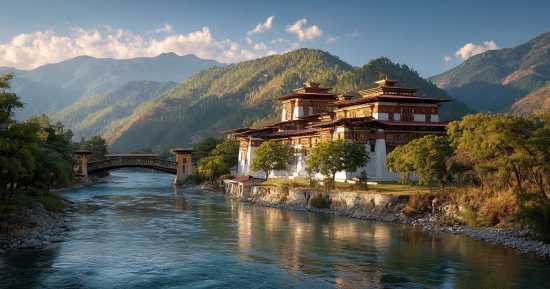
High in the eastern Himalayas, above the sky, the Bhutan History Quiz unveils a nation where culture thrives in every village and mountain valley. Bhutan celebrates its identity with vibrant festivals, breathtaking craftsmanship, and flavors that tell stories of generations. Its people live in harmony with their land, cherishing customs that have shaped their daily lives. From handwoven textiles in bold patterns to dances performed in ornate masks, every tradition carries deep meaning. Markets bustle with laughter, fresh produce, and artisans proudly sharing their work. Bhutan remains a land where history lives not in books but in the rhythm of everyday life.
Bhutanese festivals transform all the time the entire communities into theaters of color and sound. Locals gather in ornate garments, joining dancers whose movements preserve centuries-old storytelling. Markets brim with spices, handmade crafts, and local delicacies that reflect regional pride. Music fills the air, blending ancient instruments with spirited vocals that connect young and old. Families pass these experiences down through generations, ensuring their heritage remains vibrant. This living culture brings together artistry, food, and celebration in a uniquely Bhutanese way.
The Bhutan History Quiz captures this essence of connection and creativity. Craftspeople use skills learned from their ancestors to create intricate woodwork and textiles. Communities celebrate seasonal events that strengthen their shared identity. Traditional foods, from buckwheat pancakes to aromatic stews, showcase the nation’s culinary roots. In Bhutan, every festival, meal, and story strengthens cultural ties. Its history endures through daily acts of beauty and belonging.
7 Fun Facts About Bhutan History Quiz
- Bhutan is known for its colorful Tshechu festivals featuring elaborate masked dances.
- Chili peppers are considered a staple ingredient in Bhutanese cooking, not just a spice.
- Traditional Bhutanese textiles, called kira and gho, are handwoven with intricate designs.
- Markets in Bhutan often double as social gathering spaces for entire villages.
- Music in Bhutan frequently features the dramyin, a traditional string instrument.
- Bhutanese art often incorporates symbolic patterns inspired by nature and local folklore.
- Storytelling is a popular way of teaching cultural values and entertaining families.
Festivals and Cultural Traditions
Bhutan’s festivals light up towns and valleys with music and dance. Villagers wear traditional dress while masked performers tell stories through graceful movements. Monasteries and courtyards become gathering places where generations unite. Local cuisine adds flavor to each event, with dishes shared freely among neighbors. These celebrations embody Bhutan’s sense of community and cultural pride.
The annual Tshechu festivals highlight Bhutan’s rich cultural heritage. Dancers perform in brightly colored masks, captivating audiences with symbolic performances. Stalls selling handcrafted goods and regional foods surround the festival grounds. Each event strengthens cultural continuity and reinforces the nation’s identity. These festivals remain central to Bhutanese social life.
Bhutan’s markets serve as cultural crossroads. Farmers display fresh produce, while artisans offer intricate textiles and carvings. Shoppers mingle, exchanging news and laughter. These lively spaces connect rural and urban communities. Markets remain vital for cultural preservation and social interaction.
Art, Music, and Culinary Heritage
Bhutanese art reflects harmony and tradition. Painters create intricate works inspired by nature and daily life. Skilled artisans craft wooden sculptures and finely woven textiles. Each piece tells a story tied to Bhutan’s cultural roots. Artistry in Bhutan remains both functional and symbolic.
Music forms the heart of Bhutanese celebration. Traditional instruments, such as the lingm and dramyin, accompany dance performances and festivals. Songs teach history while uniting communities. These melodies pass from elders to the young, preserving cultural identity. Music remains an unbroken thread connecting Bhutan’s past and present.
Cuisine in Bhutan is bold and comforting. Chili peppers play a starring role in many dishes, such as the beloved ema datshi. Buckwheat, red rice, and fresh vegetables highlight local agriculture. Meals serve as moments of connection and tradition. Food reflects both resourcefulness and cultural pride.
Community Spirit and Living Heritage
Bhutan’s close-knit villages showcase remarkable community spirit. Neighbors share harvests, celebrate milestones, and gather for cultural events. Elders guide the younger generation in traditions that shape identity. These bonds create a deep sense of belonging. Cultural heritage thrives because of this unity.
Storytelling remains a cherished practice in Bhutan. Families gather in the evenings to share folktales rooted in wisdom and humor. These stories entertain while passing down essential values. Oral tradition keeps history alive in every household. Through storytelling, culture continues to flourish.
Bhutan balances progress with tradition seamlessly. Modern centers embrace art, music, and crafts while rural villages safeguard ancestral customs. This blend ensures Bhutan’s history stays relevant. Heritage evolves while staying anchored in timeless values. Cultural pride remains a shared national strength.
7 Serious Facts About Bhutan History Quiz
- Bhutan measures development using Gross National Happiness, emphasizing cultural preservation.
- Handwoven textiles remain one of Bhutan’s most respected traditional crafts.
- Festivals in Bhutan play a central role in maintaining cultural identity.
- Bhutanese cuisine reflects high-altitude farming practices and local ingredients.
- Artisans pass their craft skills down through generations.
- Music and dance are used as tools of historical education in Bhutanese communities.
- Oral storytelling ensures Bhutan’s historical knowledge remains accessible to every generation.
Bhutan History – FAQ
Bhutan’s historical isolation, characterized by its geographical location and limited external interactions, has had both positive and negative effects on the country’s development. While isolation preserved Bhutan’s unique cultural heritage and traditions, it also hindered economic progress and technological advancements. This isolationist approach has set Bhutan apart from many other nations, contributing to its distinctiveness on the global stage.
